
Port Hardy is a small fishing village at the northern end of Vancouver Island, a one hour flight in a small plane from Vancouver. Returning to the Queen Charlotte Strait to dive for the first time since the 1990s was both intimidating and exciting. In addition to two dive trips on live-aboard dive boats (the Sea Venture) back then, we also had fond memories of a kayaking and camping trip we did (probably 1995?) with an guiding outfit called Northern Lights, which I think doesn’t exist anymore. We camped on soft mossy Indian middens (no longer allowed, I learned this trip) and at one point, held our breaths ecstatically as orcas circled our kayaks and we waited to see where they would surface.
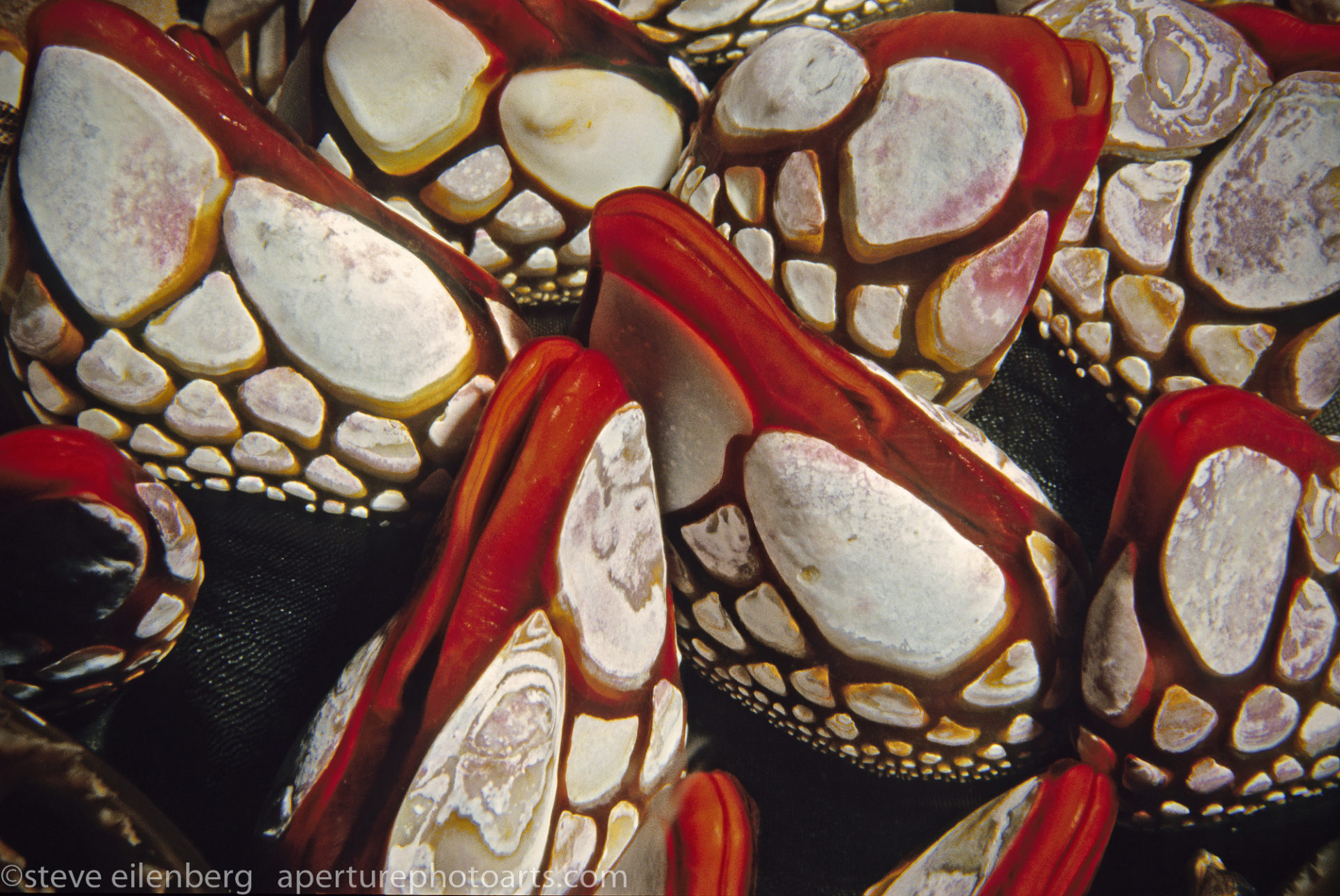
Great memories from past trips to British Columbia: Gooseneck barnacles at Tremble Island (aka Turret Rock)-I remember it as Tremble Rock . Situated in narrow Seymour Inlet, at peak flows of the Nakwakto Rapids, the islet shakes. After we did our dive here, Al drove the boat alongside, barely making headway against the current.
Our two prior live-aboard dive trips were equally memorable. Both were with our friend Dave, who lives in Seattle and was then quite an accomplished drysuit diver and videographer. He encouraged us, saying we had the cold water training and drysuit skills necessary. Back then we did a lot of southern California drysuit diving, mostly in the Channel Islands. Diving in British Columbia (BC) requires local expertise to properly time dives to the tides, to avoid being in the water during extreme currents.

These glassy smooth water surfaces bely the currents lurking beneath, which can be ripping. Diving is generally timed for slack tide, when currents are weakest. Those very currents and the nutrients they convey are what produce the profusion of life hidden beneath.
Dave reassured us that our first dive would be a gentle, “check out” dive in a protected area. Both Steve and I had a similar reaction on our first BC dive, as we raced faster and faster, with bigger and bigger, increasingly alarmed eyes, as if flushed down a river. We both were thinking “if this is the introductory dive…?” Emerging from the water, our experienced captain, Al Spilde, apologized profusely. He had inadvertently put us into the water an hour off ideal-he had been home recently and forgotten to change his watch from Daylight Savings. The rest of the trip seemed comparatively easy and we enjoyed it so much that we returned with Dave and our friend Greg in April 1998 for a second trip.
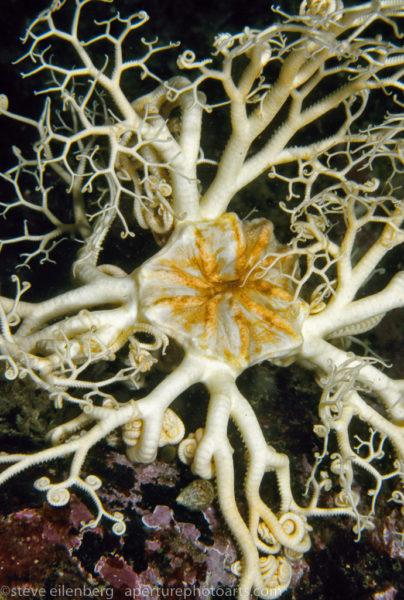
Another oldie but goodie, from our 1990s British Columbia trips on the Sea Venture with Al Spilde: a basketstar unfurls into the current to feed.
Why had it been so long since? Getting older, with Steve having more spinal stenosis back issues and dreading wearing the 30+ pounds needed to offset the buoyancy of a drysuit, was a major factor. After his successful surgery in March 2020, we were tiptoeing back into cold water diving, beginning in the Channel Islands in 2018 and 2019, and encouraged enough to book a return trip to BC with Alex Mustard for the fall of 2020.
The pandemic derailed those plans, at least temporarily. The trip was postponed two years. Surely the pandemic would be over by then?
Friday, September 16, 2022
By the time our rescheduled trip rolled around, two years later, it had been 3 years since our last cold water trip and almost 2.5 years since our last diving of any kind. We were frankly intimidated to resume diving in British Columbia, of all places.
I persuaded Steve and Greg that we should do a dress rehearsal trip to the Channel Islands before, to work out our gear and confidence kinks and found a 5-day trip going over Labor Day weekend, on the Vision, with Adventure Sports from Santa Cruz. The Vision had been refurbished and safety features upgraded since our last trip, a week before the Labor Day 2019 tragedy engulfing Vision’s sister ship, the Conception.
The trip did reassure us that we still knew how to dive in drysuits and that our camera systems were still watertight after two and a half years of storage.
I had an 11 am departure stuck in my mind. Our actual 1 pm departure to Vancouver was mildly delayed. We had to overnight in Vancouver to be positioned to catch the Saturday Pacific Coastal flight to Pt. Hardy the next morning.
After depositing our luggage (8 bags: 2 rolling duffels with dive gear, a rigid overflow rolling suitcase for clothes and drysuits, Steve’s large battered grey plastic Pelican camera case, 2 photo backpacks, a computer bag and my rolling carry on size Tamrac camera suitcase) at the Fairmount, wonderfully convenient in the airport, we hopped onto the Canada line train from the airport, heading into town to the Waterfront (the last stop). Greg boarded the train and met us en route. We walked off a few calories en route to Forage, where we shared an excellent meal of east and west coast oysters, stinging nettle gnocchi, spicy sweet cast iron pan bread served in a skillet, halibut with crispy chickpeas, sablefish collars with pickled turnips and radishes and dry aged duck. Haskap berries featured in cocktails as haskap sour and in the sauce enhancing the delicious duck.
Saturday, September 17, 2022
Could we walk to South Terminal?
“No!” Too far, an 8 minute drive, not an 8 minute walk as suggested by the girl at the Fairmount’s front desk, who was probably referring to the Domestic Terminal.
Several of our fellow workshop participants were there: Brook from southern California , Ross from Houston , Nick and Peter from the Netherlands.
The 9 am scheduled departure of our 19 passenger Beechcraft 1900C plane, 8 rows of one seat on each side of a narrow aisle with a triple in the back, was pushed back an hour due to weather on the Pt Hardy end, giving me time for a wonton soup breakfast at the cafe. I knew I was in Canada, reading a Pacific Coastal poster admonishing: “Did you know UNACCEPTABLE BEHAVIOR is NOT tolerated?” (Yes!)
It was a beautiful crisp sunny day in Pt. Hardy. We stood around the small airport, expecting someone to come pick us up. We weighted an hour before starting to call. The woman on the other end of the courtesy phone for the Waivin Flags taxi service exclaimed “No one told us you were coming in!”
When the bus did arrive, it was notable for a feature we would come to cherish : a hydraulic lift! On the bus, this was used for luggage. The version we would instantly love was on the Hurst Isle, the boat which took us out each day. On our prior trips, we were so frozen after 45 minutes or so in the water, that Al would unsnap our buckles and remove our fins, saying “Don’t move, it’s faster if I do it!” The boat’s lift is essentially an elevator we boarded to exit the water: stand on the platform, hold on and when it stopped at the dive deck level, we’d shuffle forward a couple of feet, offer our feet like horses being shod to Bryan the dive master to doff our fins, leaving us to shuffle forward a couple more feet to a bench to remove our gear. Genius!
While awaiting our boat pick-up in Pt. Hardy, we had lunch at Lyon’s Den near the eponymous river. I enjoyed crab cakes and a small Caesar salad. Another member of our party joined us there, Brian, who drove up from Vancouver. He is American but has lived abroad for years and now works in supercomputing in London. An eagle feeding on a stump and ducks drew me outside.
It might have been hoisting the long lens (100-400 mm, with a 2X teleconverter) to photograph the eagle, but minutes before it was time to load up the stored bags, my back began threatening to spasm. We had stored our gear in a locked room at a nearby hotel. I vaguely registered that there was already one lonely bag in there when we first opened the room, but it was only after our bags were dispersed at the resort that we realized this leftover bag had been brought by mistake. (I think it was abandoned.)
God’s Pocket Resort is an off the grid cluster of colorful wooden rustic cabins tucked into an alcove on Hurst Island, an hour by boat from Pt Hardy. Workshop trip leader Alex Mustard was waiting on the dock as we arrived. Our stay was the second of two back to back sessions for Alex. Another Brit, Graham, was also already at the resort, having signed up for both.
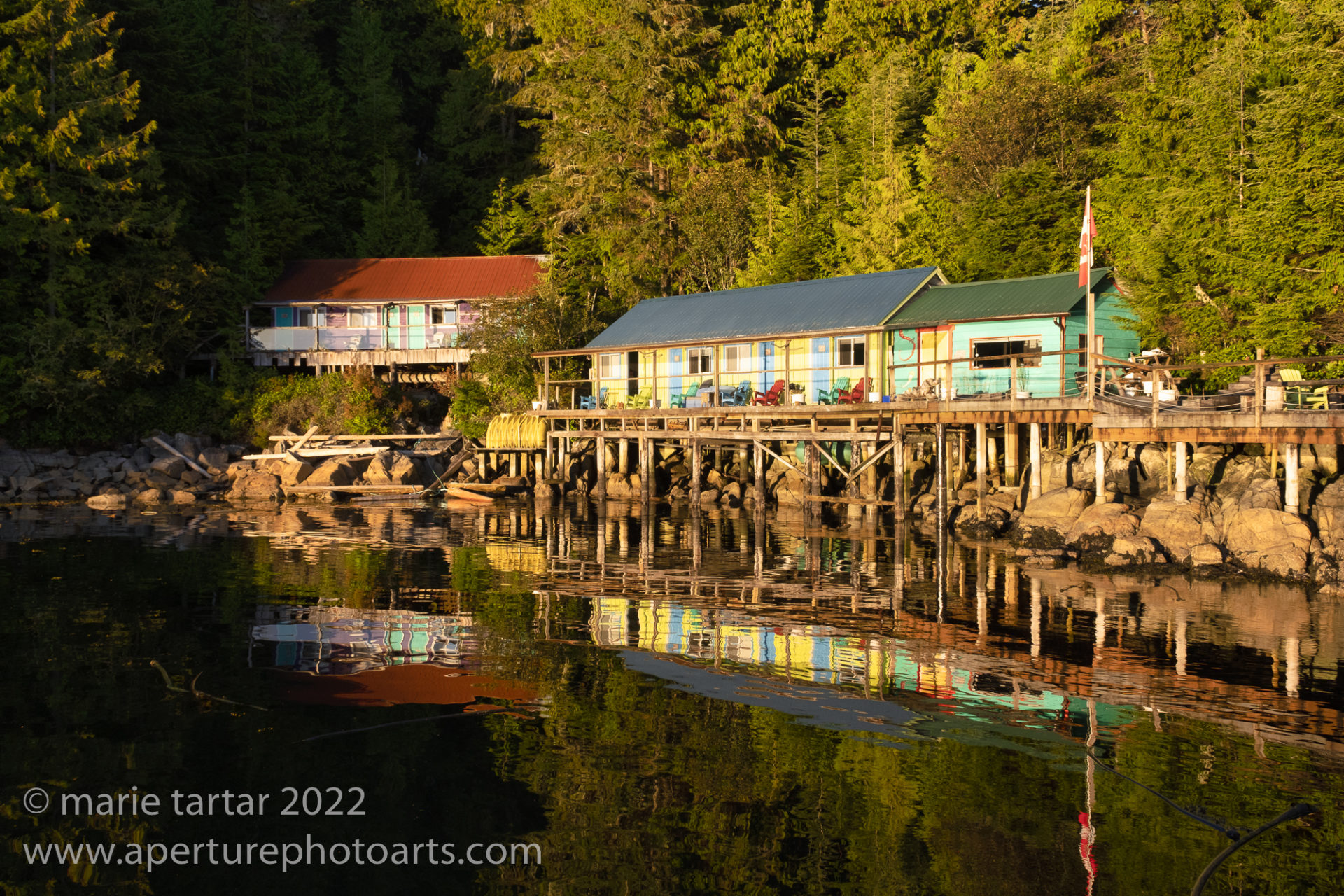
God’s Pocket Resort, a little slice of cold water diving heaven, Hurst Island, north of Vancouver Island, British Columbia.
At God’s Pocket (GP), we met the crew, including our dive guide, Bryan, and boat captain, Chris. I had a good time reminiscing with Chris, whose mentor, Al Spilde, was our captain on our two prior live aboard trips in the latter half of the 1990s (maybe 1996/1997?). Claus, one of the owners of GP, was also at the resort during our stay. The hearty and delicious food was prepared by Sage.
Our bungalow was rustic, but comfortable, especially once the radiant heat in the ripply floor kicked in. It was an adjustment, a momentary shock, seeing brown water swirl in the toilet and issue from the sink (the preferred term is “tannins”). There was a reassuringly clear drinking water tap as well. Our porch was embellished with a driftwood barrier from the drop-off.
Sunday, September 18, 2022

Waking up at Hurst Island, home of God’s Pocket Resort, on our first morning to vastly different conditions.
Each day, the schedule was written on a white board outside the dining room. Usually, breakfast was the first item on the agenda, followed by a 2-tank dive in the morning. We’d return for lunch at GP, then head out again for an afternoon dive. Today a dock dive was also offered after dinner, although neither of us took advantage of it. It was chilly overnight and we awoke to a fog-transformed landscape.
Dive 1: Hoodi Nudi Bay (28 min, 44 ft)
This was a disaster dive for me. My TankPod had malfunctioned during our Channel Islands dress rehearsal trip. Despite changing the battery at home, it was again not communicating with either wrist dive computer. It was hastily swapped out for Bryan’s pressure gauge. With problem #1 temporized, I suited up, jumped giant stride into the water, only to feel an instant shock of cold water at my left waist, across and then down both legs. This flood could only be an incomplete zipper closure leak, which I knew all too well from our recent Channel Islands trip. Back on the boat, after a dress rehearsal trip up the hydraulic lift, Chris removed a little grit keeping the zipper from completely closing. My legs were damp but the quilted thermal suit seemed to have sopped up the excess liquid, so I jumped in again and promptly sank to the sandy floor-overweighted! Then I discovered my strobes weren’t working even though both had worked perfectly on testing the night before. Maybe that tinge of red I saw the night before on the edge of the flash sensor meant the battery was about to fail? Evidently, I was still learning nuances of this camera system. I cut the dive short.

Although a disaster dive for me, Steve obtained some lovely shots of the breeding Melibe leonina hooded nudibranchs.
Dive 2: Aquarium
Greg tried a new innovation in drysuit donning, with THE HANGER still inside. I sat out the second dive with Bryan and Chris on the boat. I had to pee in the women’s toilet, basically like a child’s potty, shielded from view by a dive flag strung across the bow compartment as a curtain. Steve committed a toilet faux pas by failing to hear the instruction for men to pee directly into the water. The head he used is under construction, a work in progress. Chris: “If he did that last week, it would have been all over the floor!”
A spell in the warm room inside out for the drysuit and a fresh water rinse and spin in the dryer for my drysuit underwear set me up to try again after lunch for the 4 pm dive. Posted dive times are strict boat departure times. Suiting up takes long enough that preparations start half an hour before the very prompt departures which are timed for slack tides.
Dive 3 (of the day, my second): Hussar Point
47 min, 54 ft
Steve and Greg set me up with the analog pressure gauge we had procured as a back-up since my TankPod let me down in the Channel Islands and swapped hoses so my drysuit hose reaches the valve more easily. That was not the end of my troubles but I did manage to eek out a dive and even fire up the camera and capture a few frames. But first there was a descent into green nothingness. Seeing no one or even the target wall, I reascended, saw the wall and kelp on the surface and sank back below the surface.
I had a terrible suit squeeze which did not seem to respond to my putting more and more air into the suit. The suit squeezed me so tight, I had trouble reaching across my body to tighten the valve on my left shoulder with my right hand, since presumably all the air I was introducing was leaving the suit just as fast. I had linear marks on my shoulders later in the shower. I had to inflate my BCD to get any lift.
The wall was gorgeous, covered with white Metridium anemones and punctuated with orange sea cucumbers. Kelp streamed toward the surface in the shallows.
Back on board, Ross was already there, having managed only a 15 minute dive. The drysuit he ordered for this trip didn’t come in time, so he brought a rental suit which proved to be laughably too big. When I adjusted the neck seal for him earlier, I noticed how loose it was, way too easy to adjust and much too comfortable. By this time he was already onto drysuit #2 alternative, left behind by a buddy who was diving here last week. By day’s end, he was trying on a 3rd alternative, dive guide Bryan’s, which appeared to fit perfectly.
Brook tore her neck seal and as we approached the 3rd dive site was busily attaching a spare. However, she didn’t end up diving after all as the untrimmed seal felt too constricting when she tried it.
Monday, September 19, 2022
The night before, I had gone to bed early, collapsing with exhaustion towards the end of Alex’s presentation on wide angle photography. I woke up in middle of night with a headache-maybe dehydration? I drank some water and went back to sleep. I was up again with a headache at 5 am. This one was more insistent and didn’t budge with more water, so I took Exedrine Migraine.
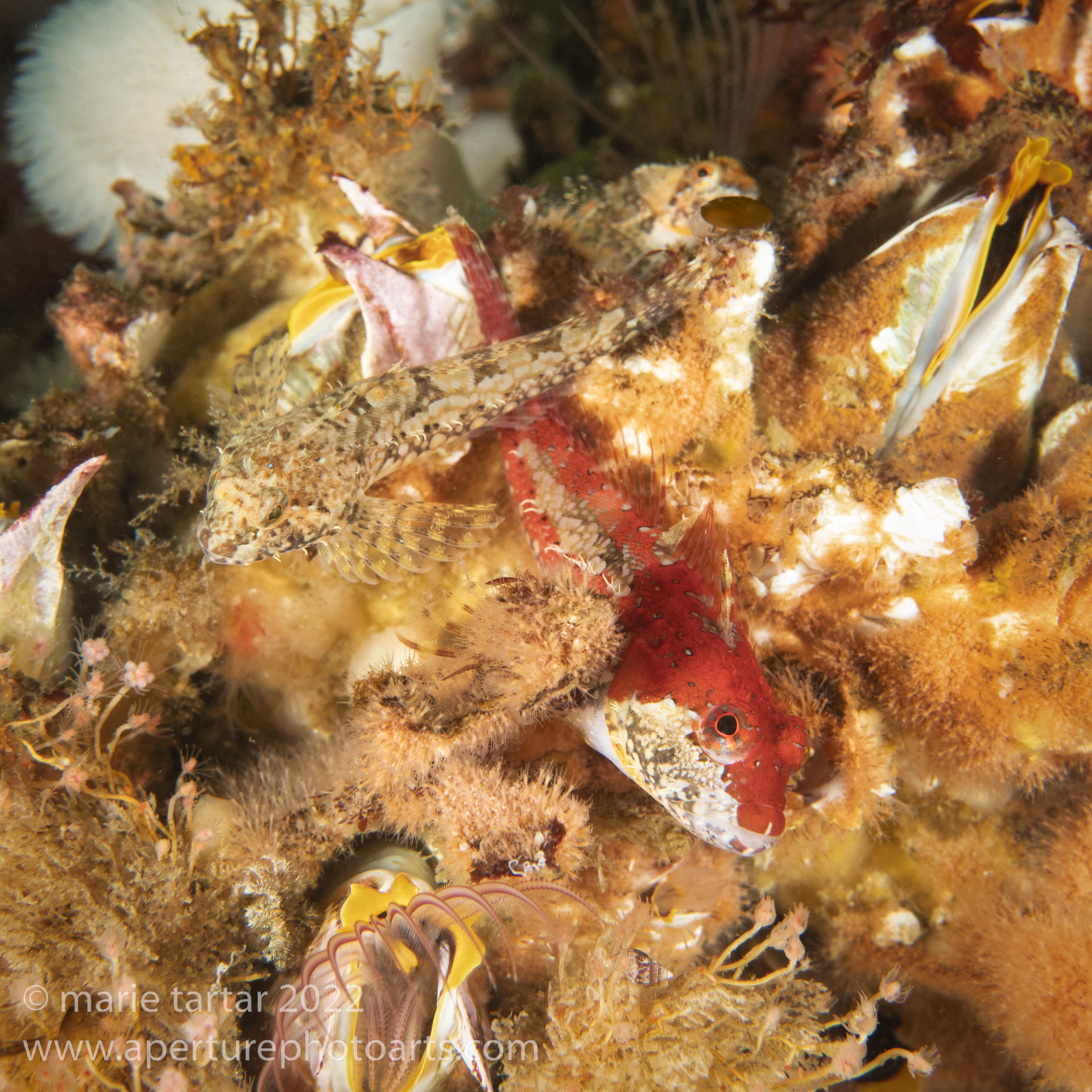
Crossing fish in a confusion of hydroids and barnacles, typical British Columbia underwater profusion. (Scalyhead sculpin (Artedius harringtoni) in two color variations.
Dive 1: Clam Wall (51 min, 51 ft)
I finally felt mostly in synch this dive with the drysuit, which is still practically new (2 Channel island 5-day trips on it, one before the pandemic). I dropped more weight, ending up with 20 pounds, including 14 pounds carried via the DUI harness I borrowed from my friend Nancy, plus 6 pounds in BCD pockets, with ankle weights (which probably weigh 3 pounds together).
Dive 2 Seven Tree Island (47 min, 48 ft)
There was a stunning profusion of life and color and a couple of sea lions skipped by briefly in the turbid green water. Red Irish lords were plentiful.
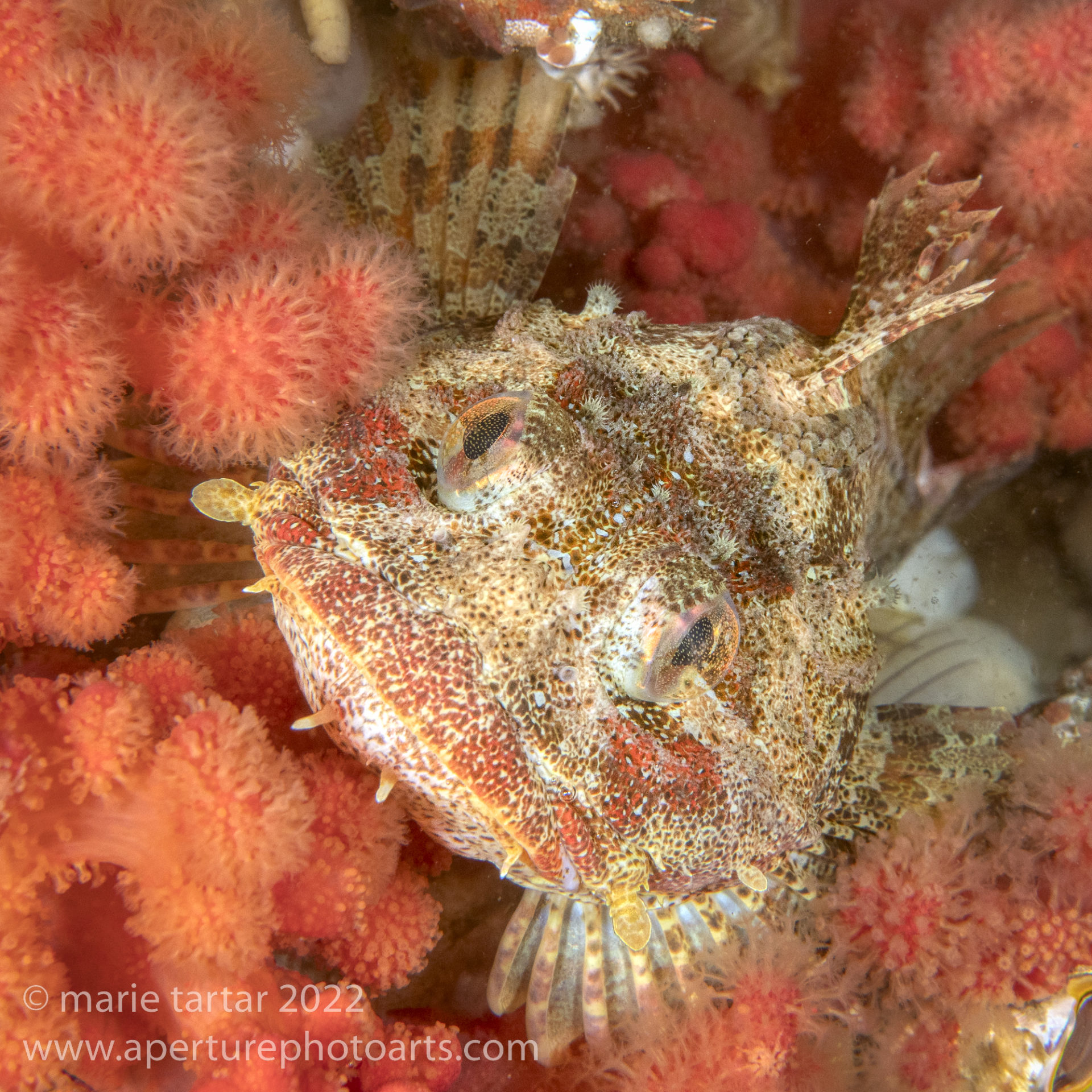
Red Irish lord, a type of sculpin, is an ambush predator, lying still until a meal is in easy reach. Consequently, they usually tolerate a photographer’s close approach.
Dive 3:Browning Wall (52 min, 52 ft)

So ugly he’s pretty? Cabezon (marbled sculpin: Scorpaenichthys marmoratus). Browning Pass, Port Hardy, Vancouver Island, British Columbia, Canada.
I almost skipped the 3rd dive, again with a little headache. I discovered my camera battery dead at last minute with just enough time for a change out.
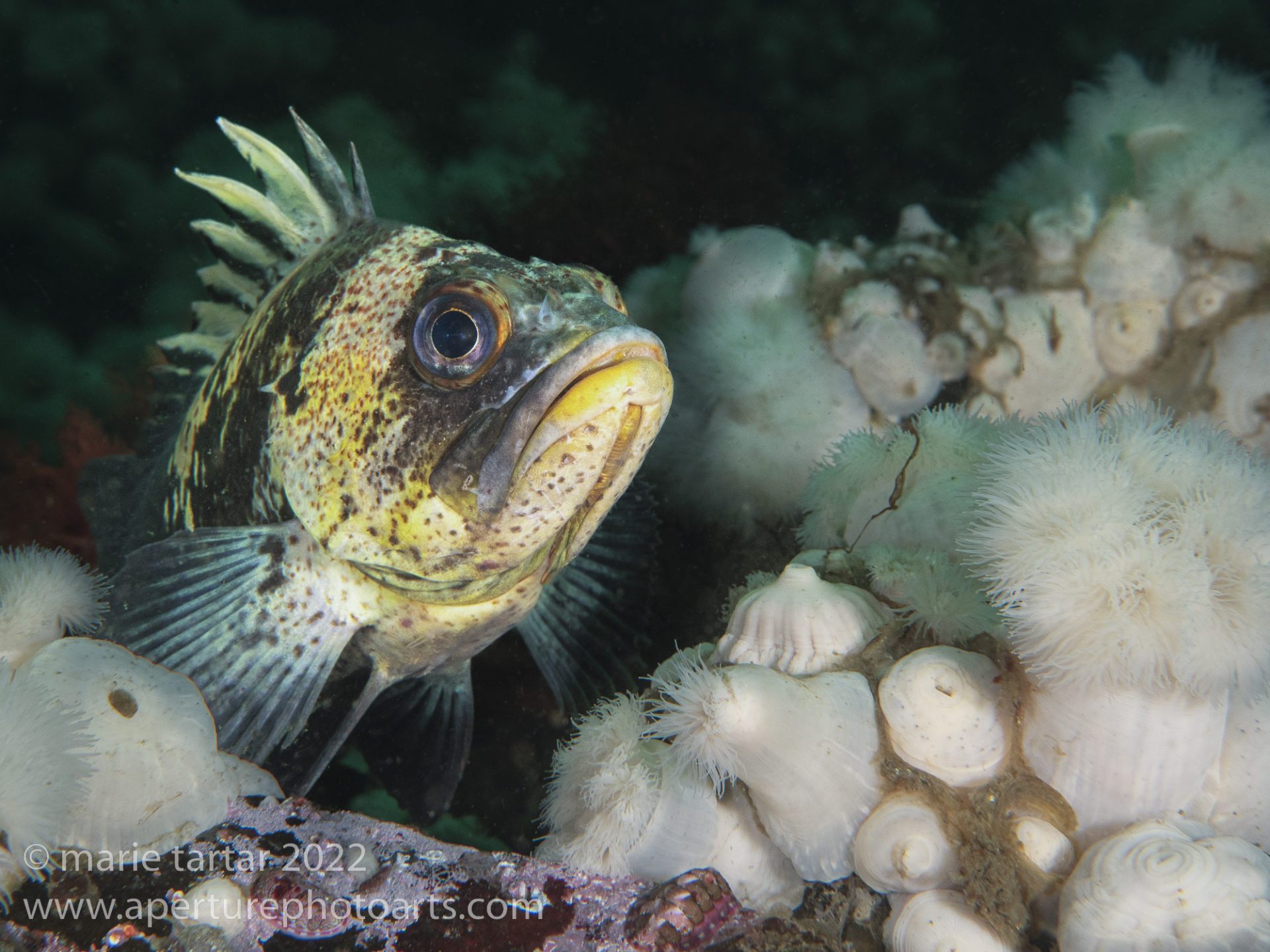
Rockfish with attitude, surrounded by a field of Metridium plumose anemones, in Queen Charlotte Strait, British Columbia.
Dinner was a warming offering of schnitzel, spatzel and red cabbage, with a spinach and beet salad. I was too beat to do the night dive. Water temperature of 50 degrees really pulls one’s energy plug.
Steve had a scary experience doing the after dinner pier dive. A war bonnet in a bottle underneath the pier was a major attraction. Trying not to kick or stir up sediment, he inflated his drysuit at 15 feet depth under the pier. This led to a slow uncontrolled ascent to the surface, pinning him to the underside of the dock, which was criss-crossed with ropes. He had to drop his camera in order to extricate himself. He later bought both of us knives, although these ropes were beefy enough that I don’t think they would have helped in this particular situation.
Tuesday, September 20, 2022
Options for women peeing while drysuit diving is a hot topic on Facebook and other forums. There are appliances (She Pee) which must be glued into place, while many resort to adult diapers. After suffering during our Channel Islands trip, even cutting a dive short due to the unbearable urge to pee, I finally decided to try padded absorbent underwear. I found it useful, sometimes psychologically, other times physiologically. Peeing on the boat between dives is not easy, as the drysuit has to be unzipped, the top doffed (over the head, arms pulled out, gloves and hood taken off), the top of the jumpsuit also doffed (an argument for separate pants and top for my next set of drysuit undies), all before baring your lower half to actually urinate.
Dive 1: Snowfall (49 min 69 ft) (macro)
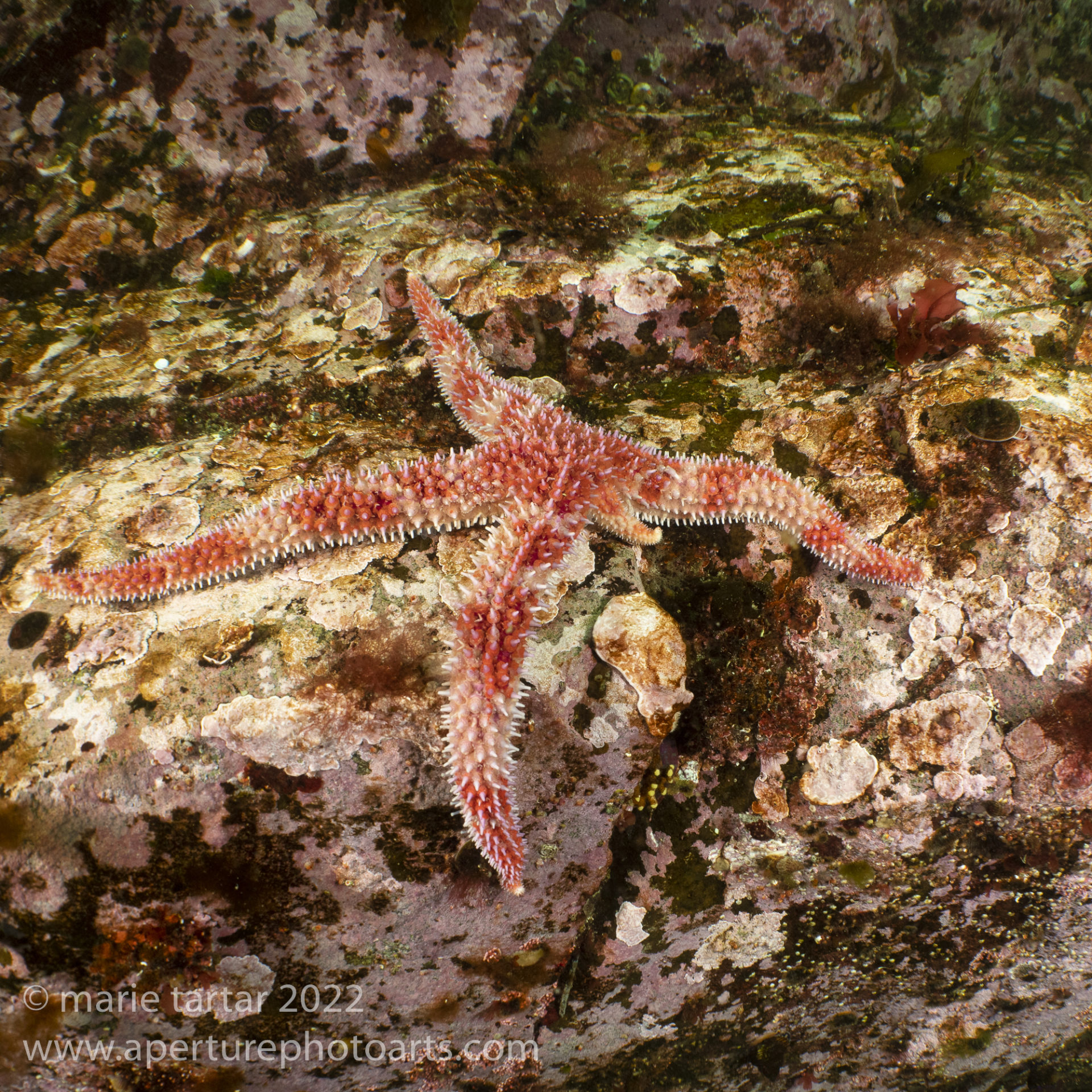
The regenerative power of nature on display in a starfish in the rich waters of British Columbia: notice the tiny “mini me” arm.
Dive 2: Buttertart (52 min 56 ft) (macro)

A pair of opalescent nudibranchs (Hermissenda crassicornis) in a tete a tete on kelp in Queen Charlotte Strait, British Columbia.
I switched to shooting macro this morning and back again to wide angle for the afternoon.

Scalyhead sculpin (Artedius harringtoni), feeding barnacle and Metridium anemones, British Columbia, Queen Charlotte Strait.
Dive 3: Ruth’s Rocks ( 54 min 50 ft) wide angle
The current may have been responsible for a strange stationary aggregation of fish I encountered toward the end of the dive. I also saw a large jellyfish at the end of the dive. One of the few animals that scare me underwater are jellyfish. They are beautiful and I love them, but I once reacted so strongly to stings from a translucent, broken jellyfish tentacle (not even the whole creature!) that I rarely get close enough to one to get a good shot.
On the way back to the resort, someone sharp-eyed among our group saw a person waving from a distant, small boat called Trophy. On the radio, Chris confirmed they were in no immediate danger, although he thought the speaker sounded a little panicked. There were 5 people aboard a 25 ft vessel which had lost its main engine and were making little headway achieving 4 knots/hour using the auxiliary.
A fishing vessel, Ocean Explorer, also responded, steaming toward them from the opposite direction and Chris let the Coast Guard know they would tow the disabled vessel to Pt Hardy. When we took leave, the Trophy was being secured alongside the fishing vessel. Thus did we participate in a minor way in a maritime rescue.
The evening included burgers for dinner, with roasted yams and Caesar salad, followed by an image review in the lounge.
Wednesday, September 21, 2022
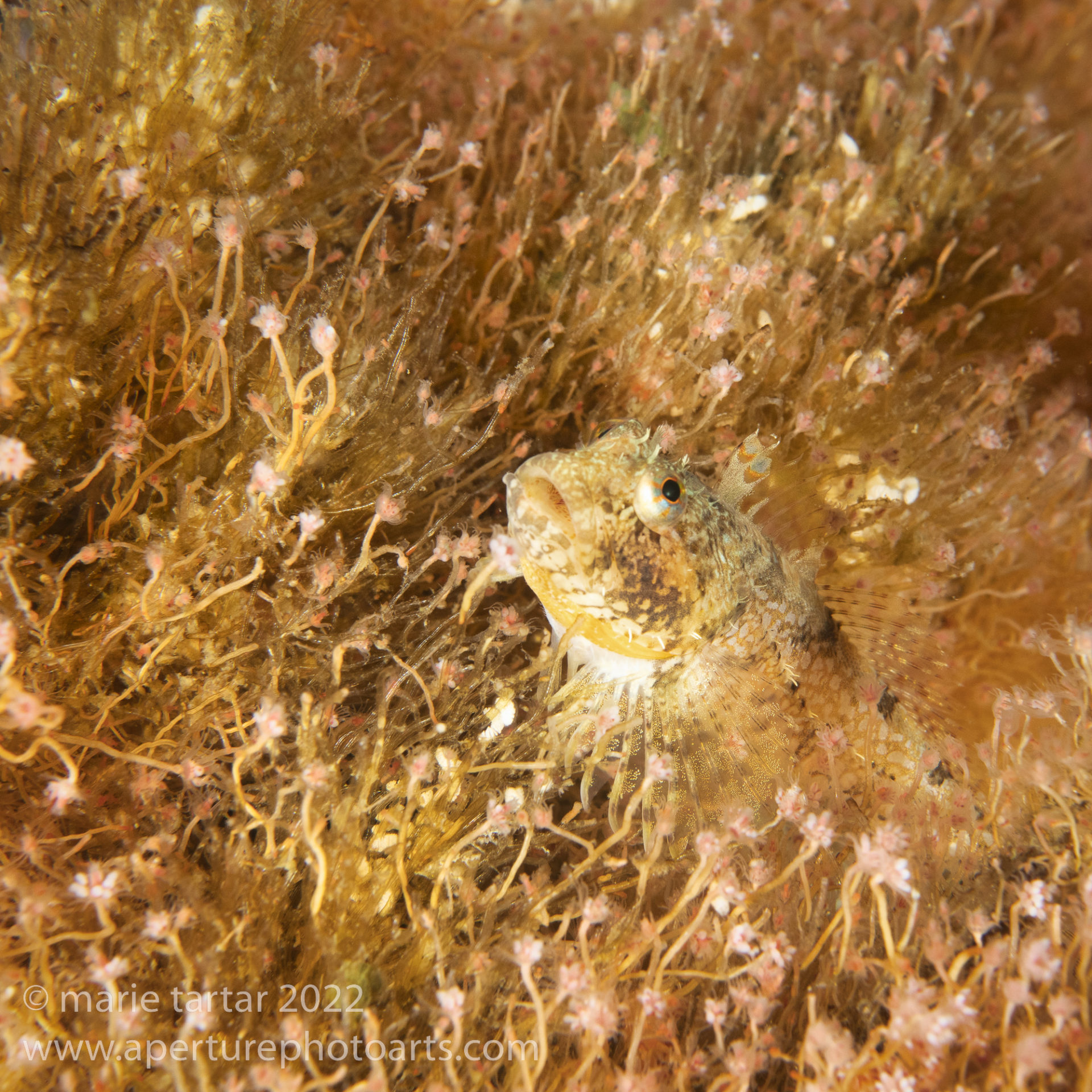
Scalyhead sculpin (Artedius harringtoni) in hydroids (Ectopleura crocea), British Columbia, Queen Charlotte Strait.
Dive 1: Hussar West (46 min 31 ft)
This was the first morning I did not awaken with a headache. Breakfast featured eggs benedict. We did single morning dive to the hooded nudibranch breeding grounds, which I had missed, as it was the scene of my first disaster dive with the flooded suit.
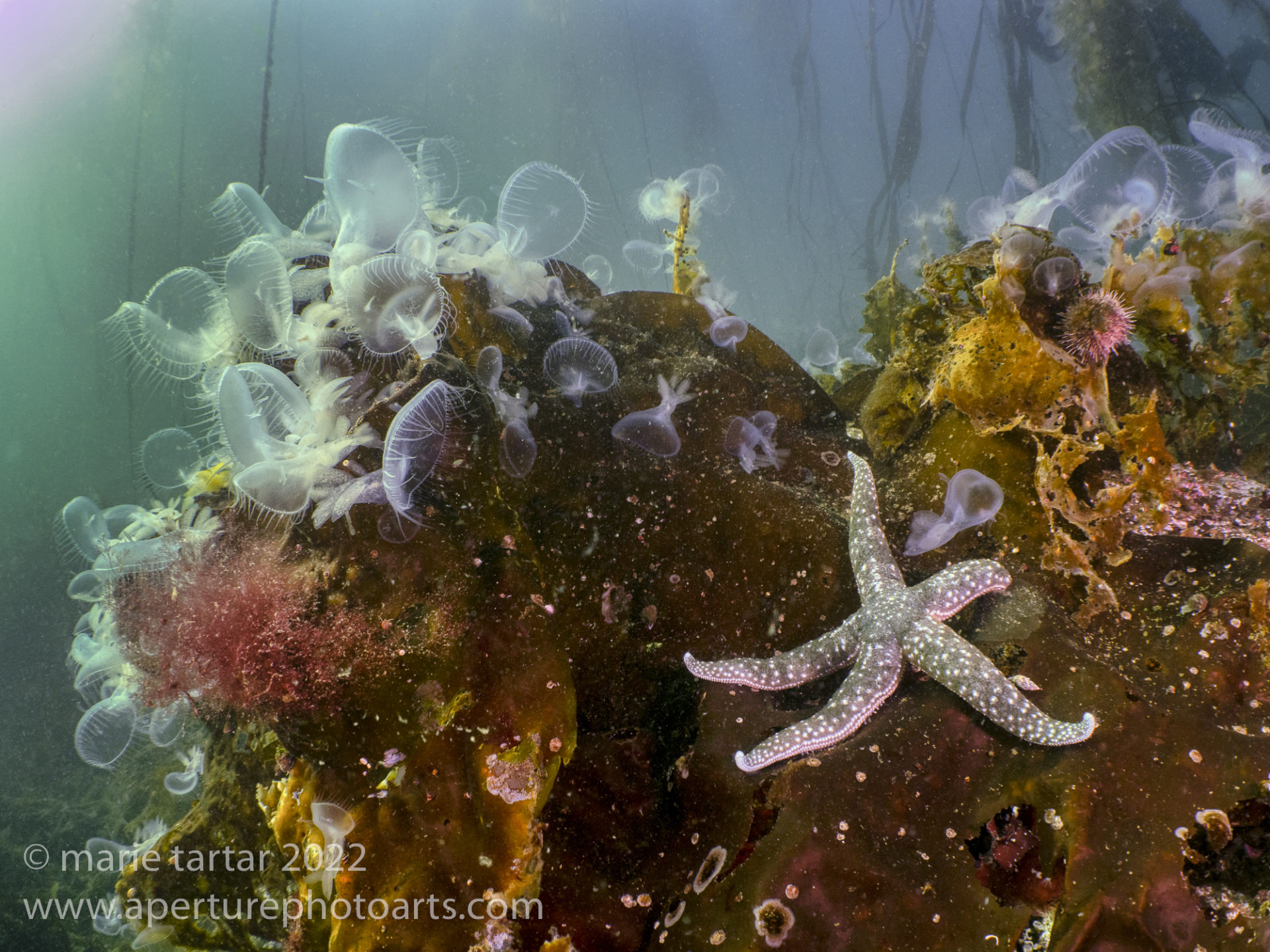
Hooded nudibranch (Melibe leonina) yearly breeding swarm happens for a few weeks in the fall in the Pacific Northwest.
Dive 2: Browning Wall (47 min 54 ft)
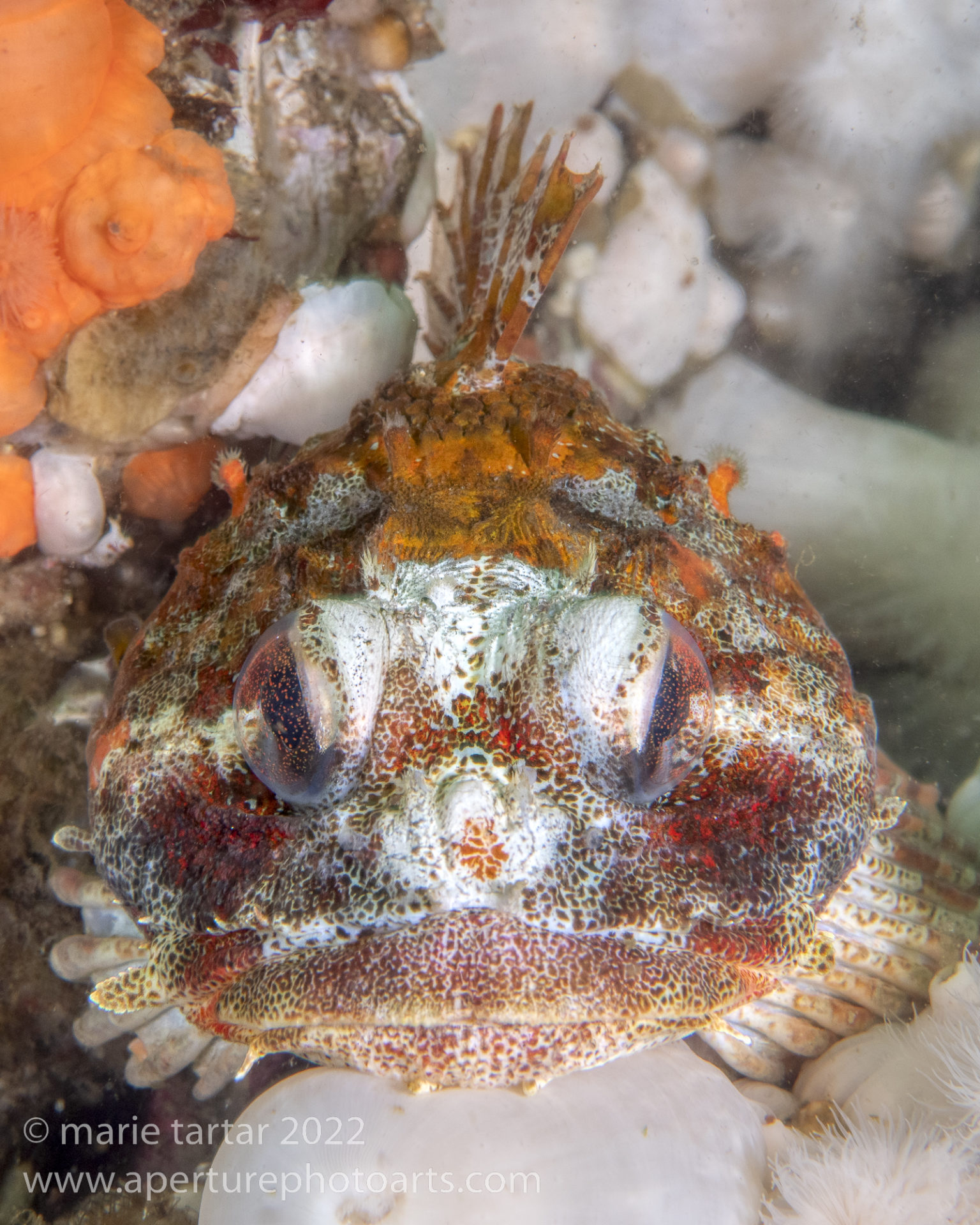
Red Irish lord resting on a Metridium anemone “pillow”. Like most ambush predators, they tolerate close slow approach, apparently believing if they don’t move, they are invisible.
Dive 3: Lucan East (43 min 27 ft)

Steve had this beautiful giant Pacific octopus (GPO) to himself for half a dive! I vividly recall seeing on a prior trip our friend Dave perch his videocamera into a crevice to film a GPO, only to have it throw out a tentacle, then another, leading to a wrestling match between Dave and the GPO for the camera. Dave ultimately prevailed.
Getting my dry neoprene gloves on is so difficult I have to rely on someone else (generally divemaster Bryan) to put them on me. I also tried diving with 5 mm wet gloves, which were good for wet gloves but definitely not as warm as dry gloves.
The shooting was tricky, trying not to stir up sediment. We had what seemed a long wait geared up, waiting for the tide to slacken.
I again skipped the night dive. Usually I love them, but 3 cold water dives are strenuous enough. We did another image review afterwards.

Hiding in plain sight in British Columbia’s underwater abundance: decorator crab, clad in grey sponge, with a little friend (did you notice the yellow scalyhead sculpin to the right of the crab?).
Thursday, September 22, 2022
The landscape was transformed by fog, through which pink hints of a veiled sun tried to penetrate.
The day started earlier than usual, with a 6:30 continental breakfast of chocolate bread. We were in search of wool eels. Bryan advised looking for slight movements.
Dive 1: Fantasy Island (53 min, 70 ft)
This is a tidal island, appearing and disappearing twice a day.
A wolf eel was found late in dive. Alex pointed me in the direction, but I only saw Graham and Brook, neither shooting a wolfie. We had seen them in abundance on our prior trips, so it wasn’t a super high priority for me, although would have been nice.
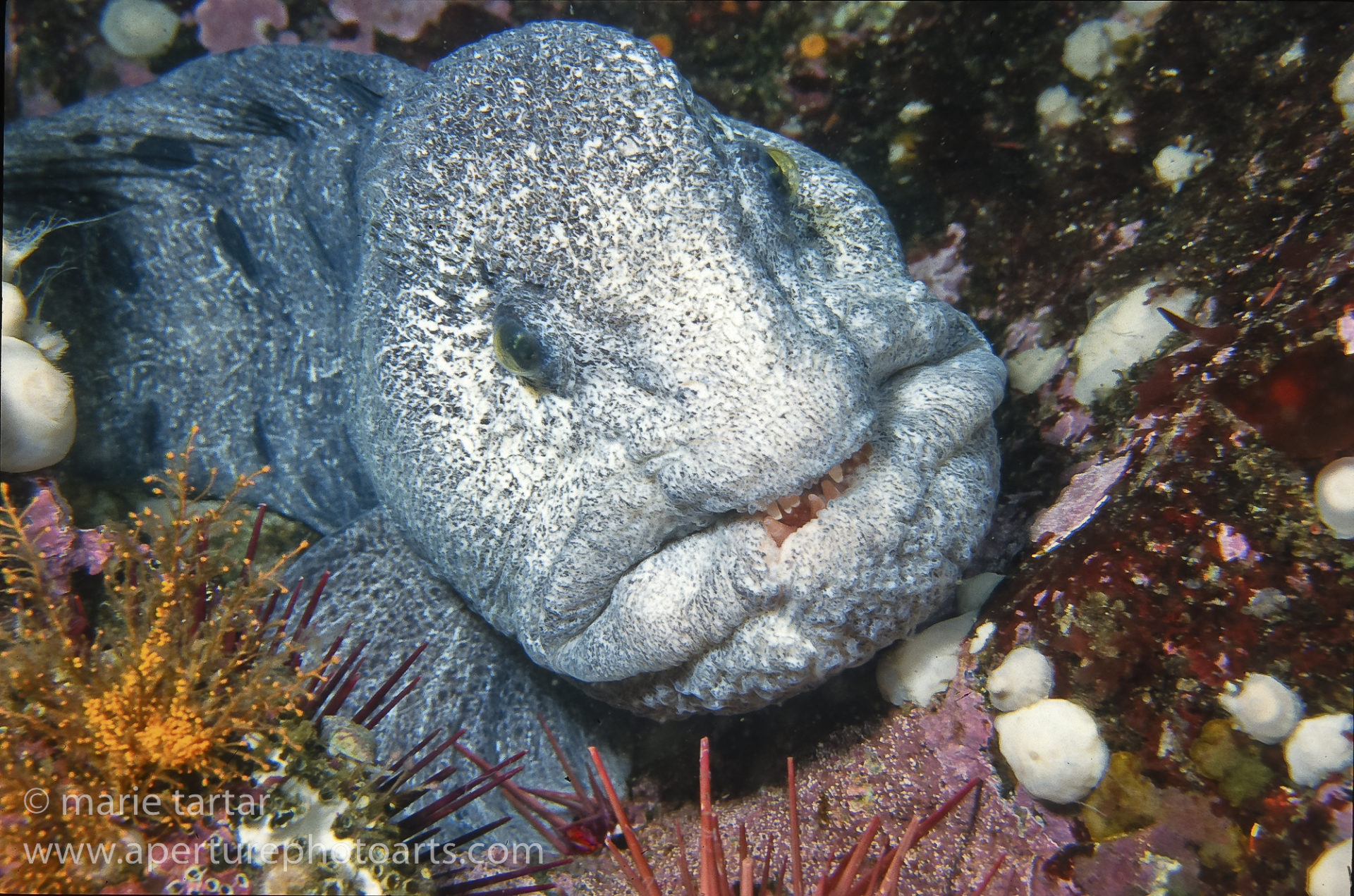
A favorite memory from British Columbia diving trips past: Greg’s first wolf eel, eager to be feed sea urchin, looped itself around his neck like a boa constrictor and looked back at him from inches away, much too close even for his 15 mm Nikonos lens.
Steve and I skipped the second dive at Hussar Point, where there was beautiful shifting landscape with drifts of fog concealing and revealing the layers of scenery. We passed a humpback blowing at Browning as we headed out and sea otters were briefly glimpsed.
After warming up, I decided to do the afternoon dive, joining Brian and at last minute, Greg. Greg’s dive ended up abbreviated, as his tank hadn’t been refilled from the prior dive.
Dive 2: Christie Corner (around the corner from GP) (34 min, 31 ft)
I found myself in a shallow, secret garden of short kelp, where anemones studded rock crevices and embellished stalks of kelp, leading to some of my favorite keepers from this trip.
Although not without some issues, we both ended up being glad we hadn’t bagged this trip. During the 2 year delay, Steve had minimally invasive back surgery which alleviated much of the difficulty he had been having from spinal stenosis. We both had wrestled with the inner voices asking if we still had it in us to drysuit dive. We missed Al coaxing out the giant pacific octopuses and the wolf eels prodding us to open sea urchins for them, as well as seeing gooseneck barnacles at Tremble Rock, but found there was still a lot of life to love in these waters. We ended really enjoying this long delayed return to BC, although I think Greg is right-next time, we should sign up for back to back trips!
-Marie
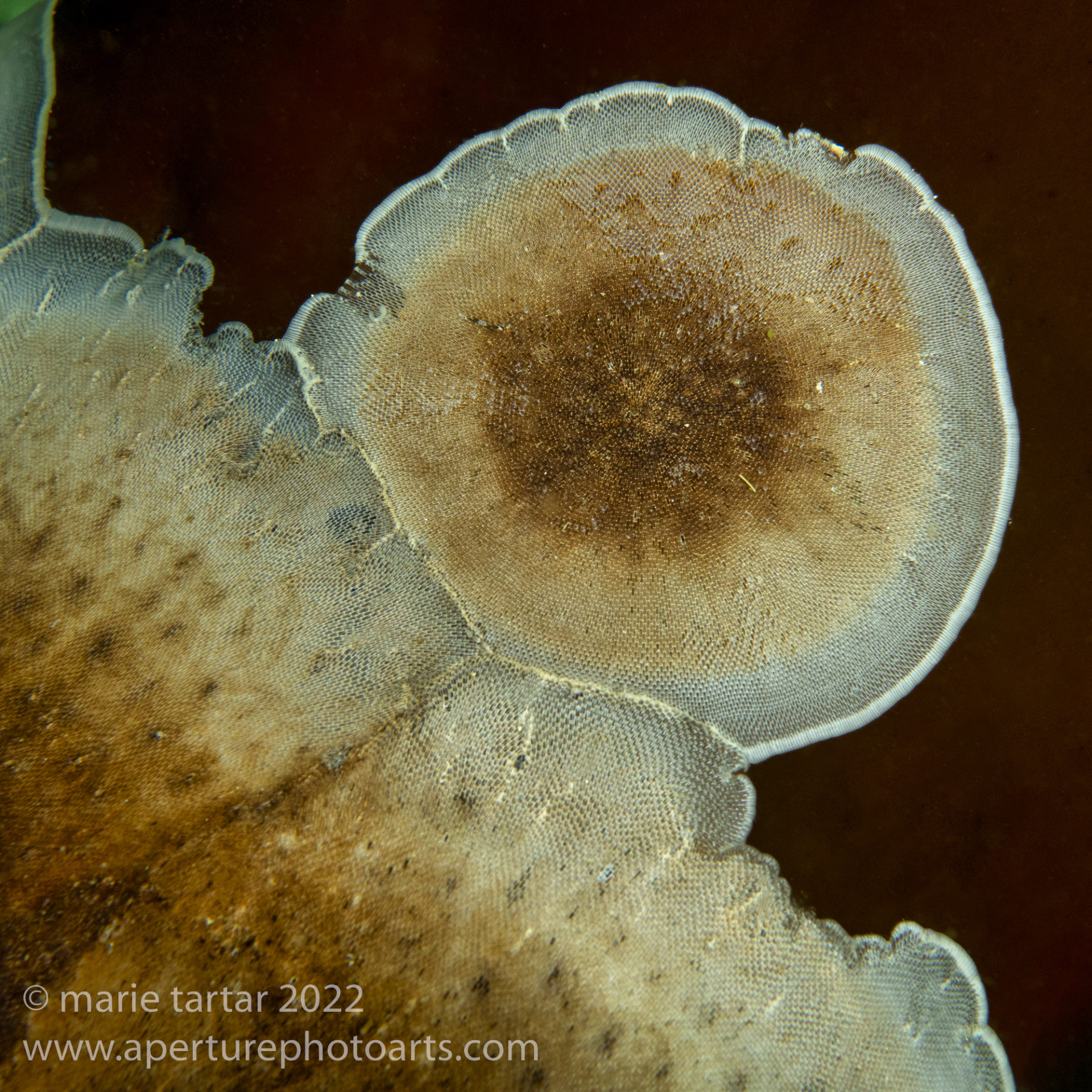
British Columbia underwater abstract: Bryozoans on a kelp leaf look like a textile or a piece of 1970s fiber art.
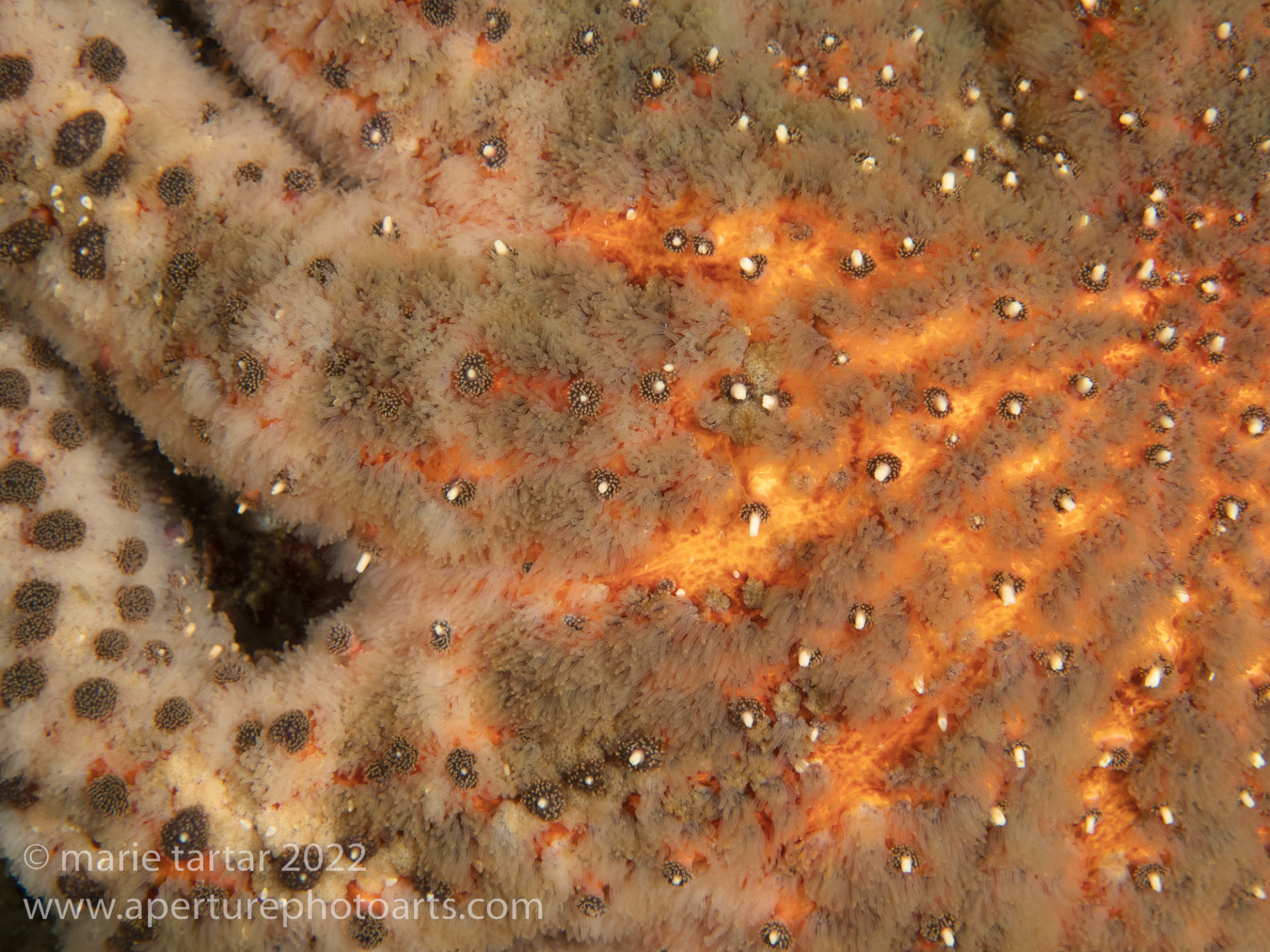
Detail of a sunflower star (Pycnopodia helianthoides) or possibly a prototype for the grooviest carpet ever?

The holiday color palette of this image of a fish-eating anemone and kelp frond aloft in the current lent themselves to 2022’s holiday greeting.

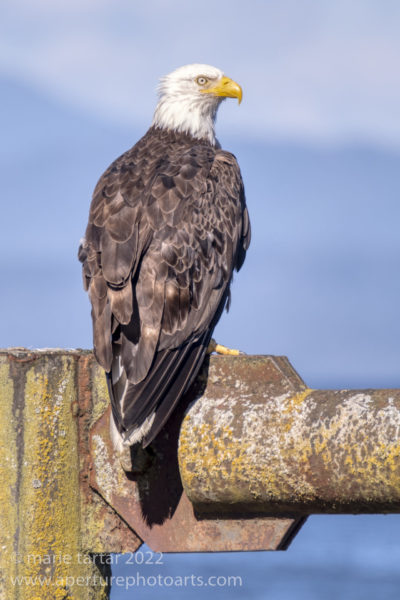
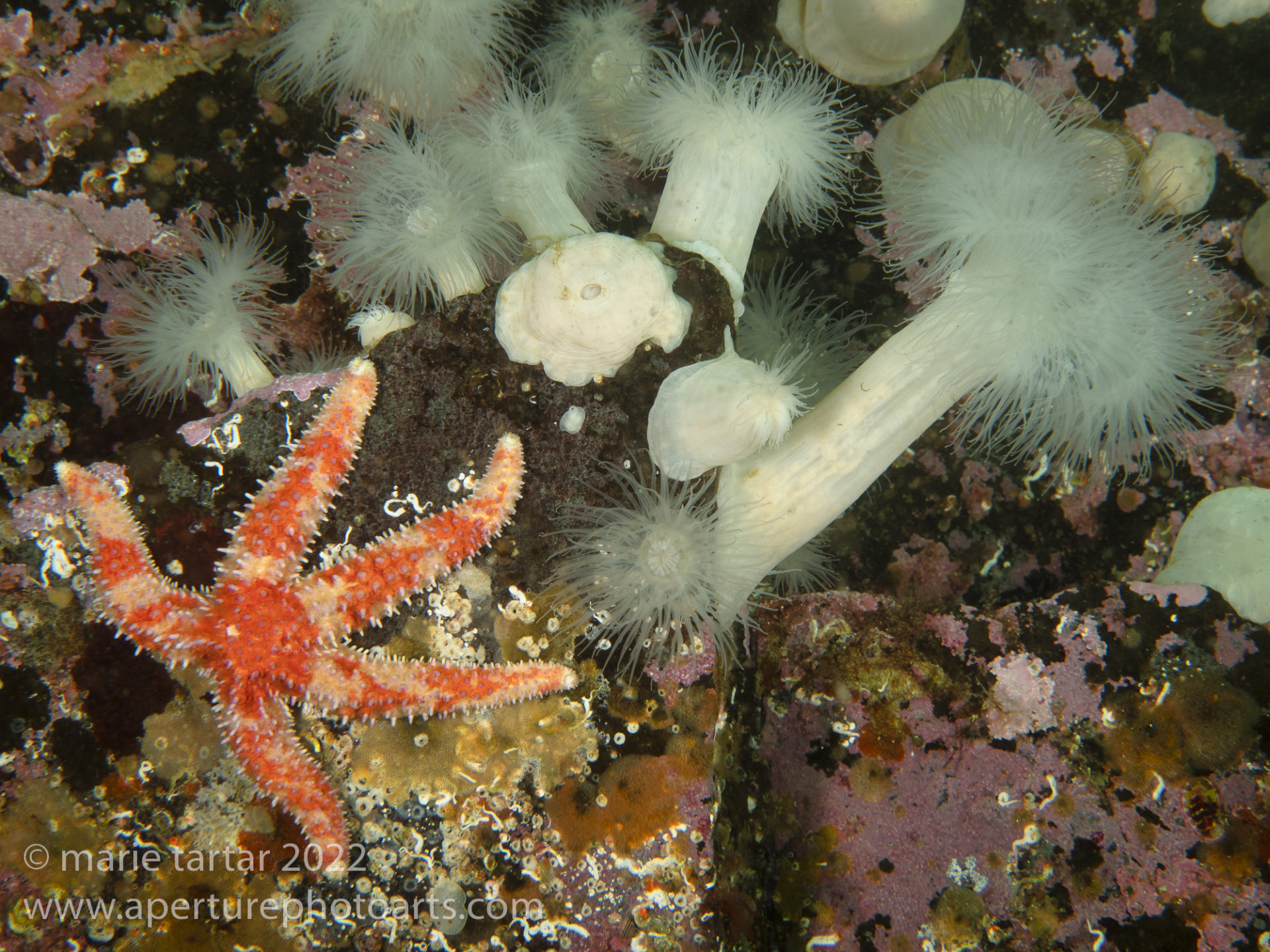
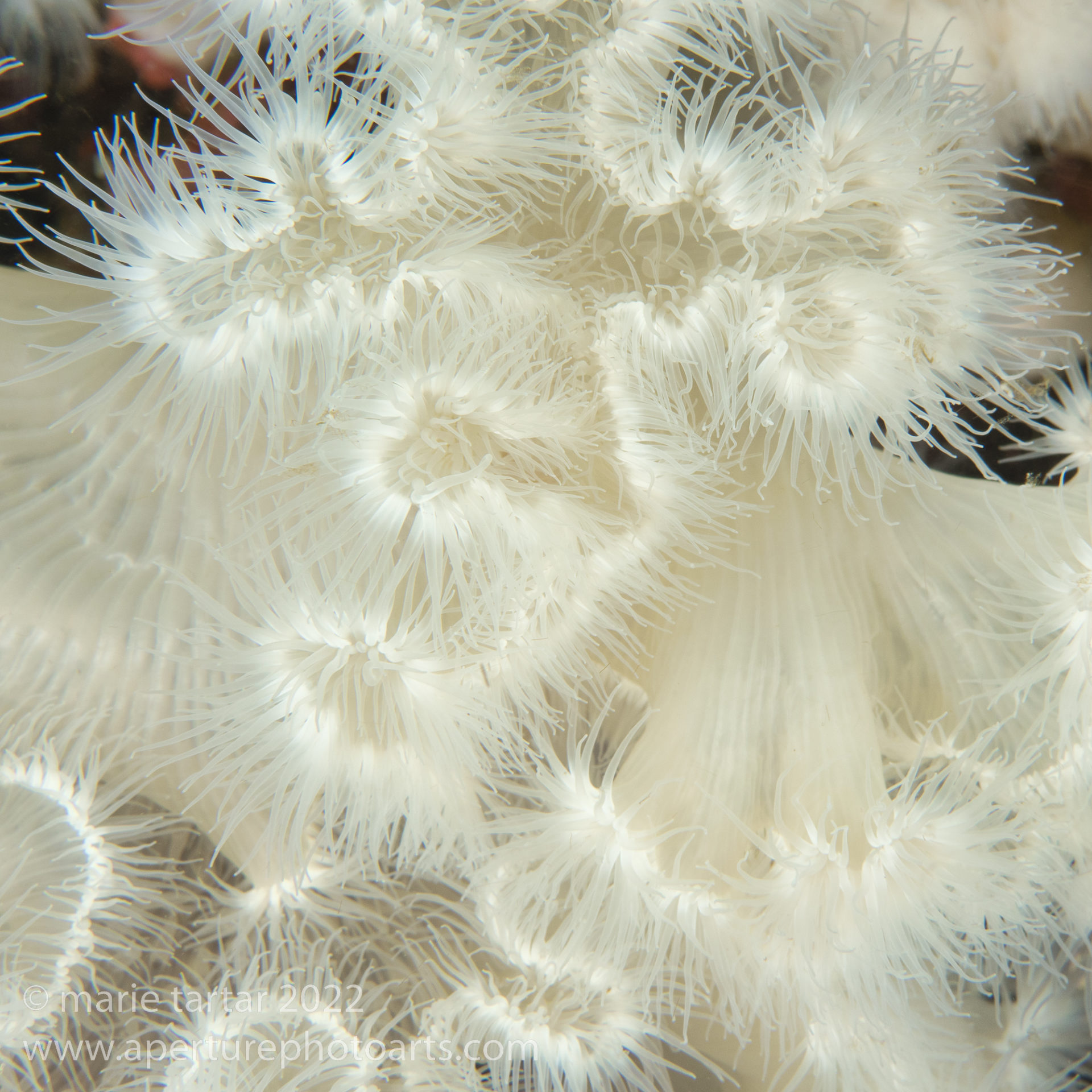
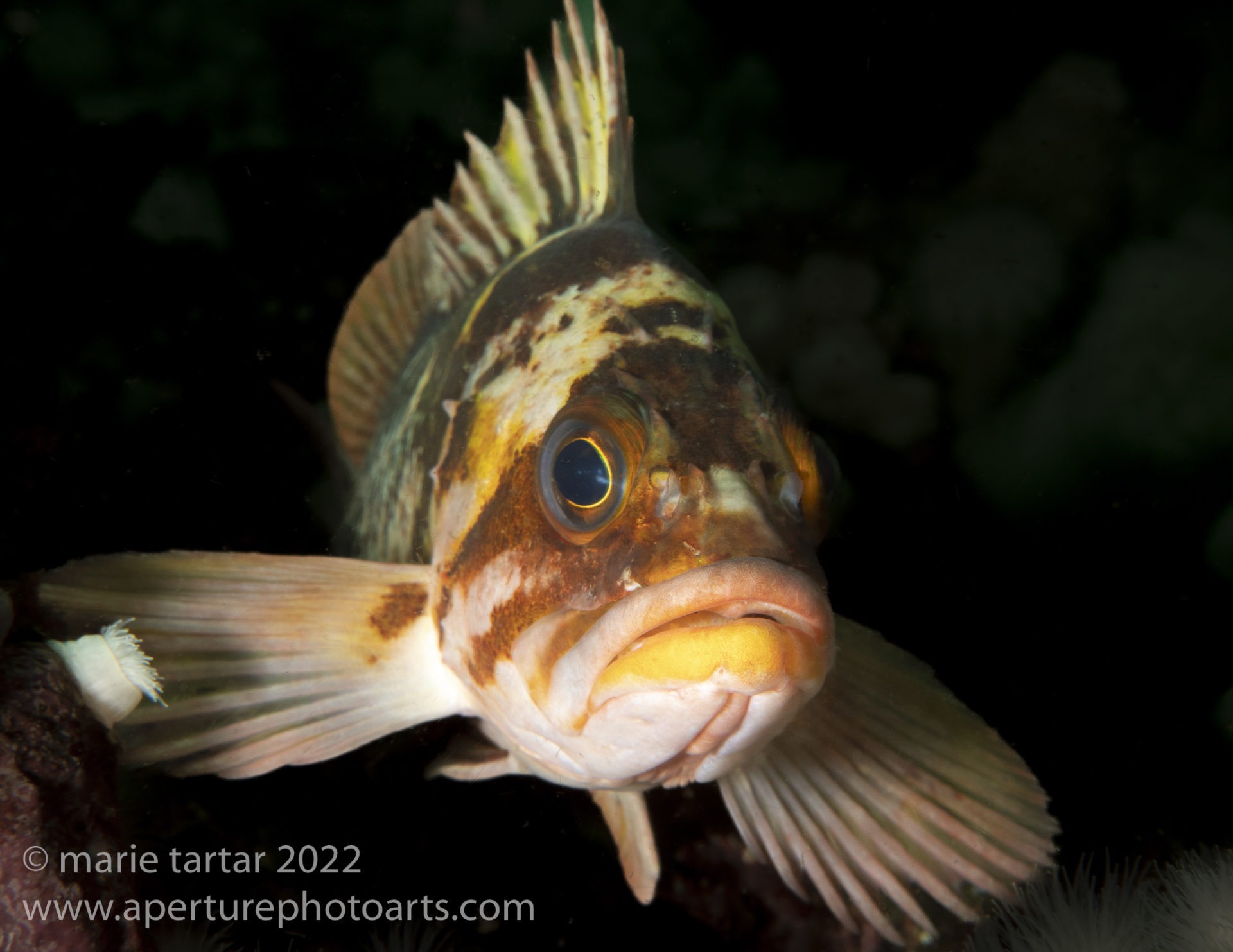
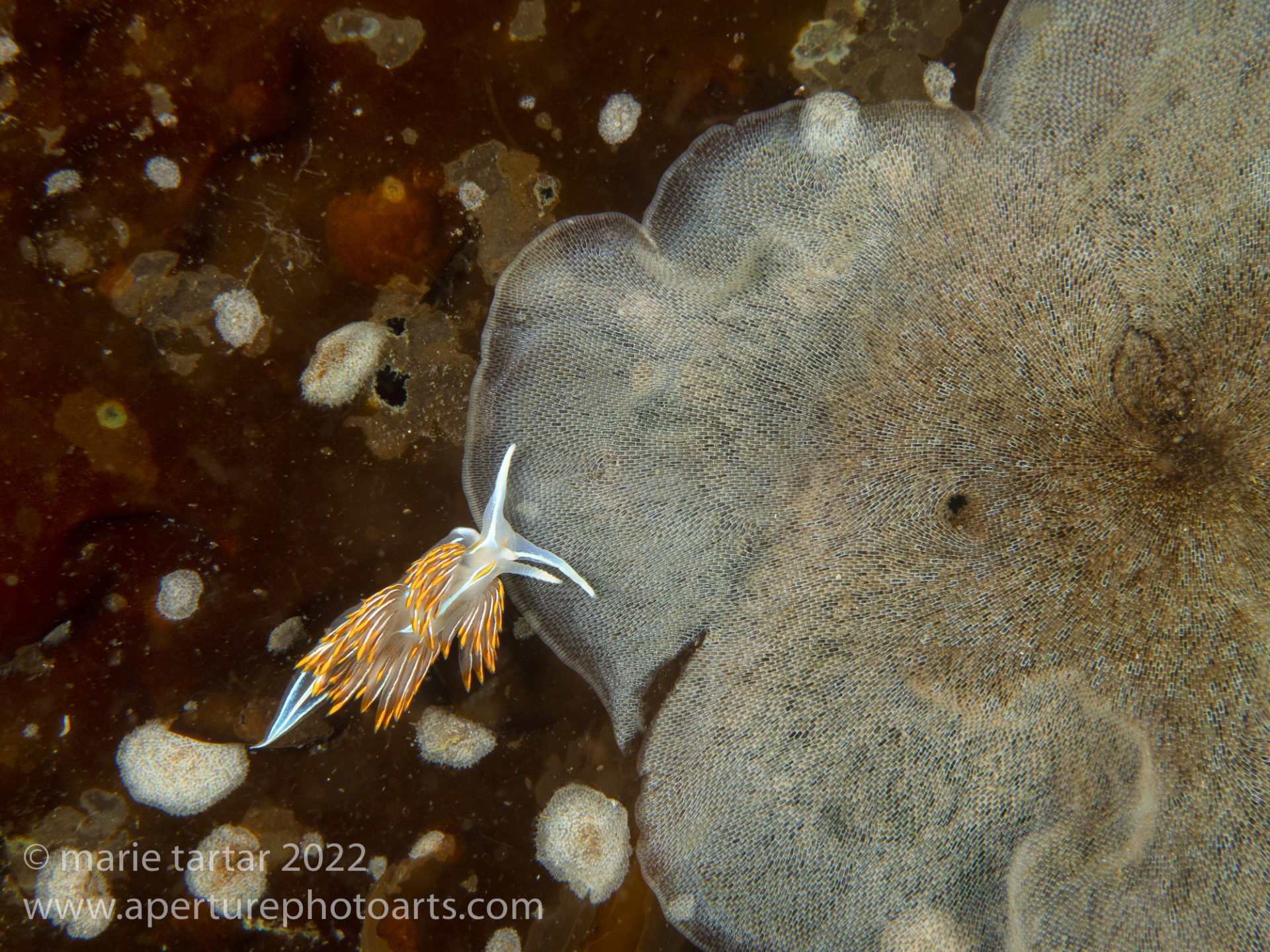
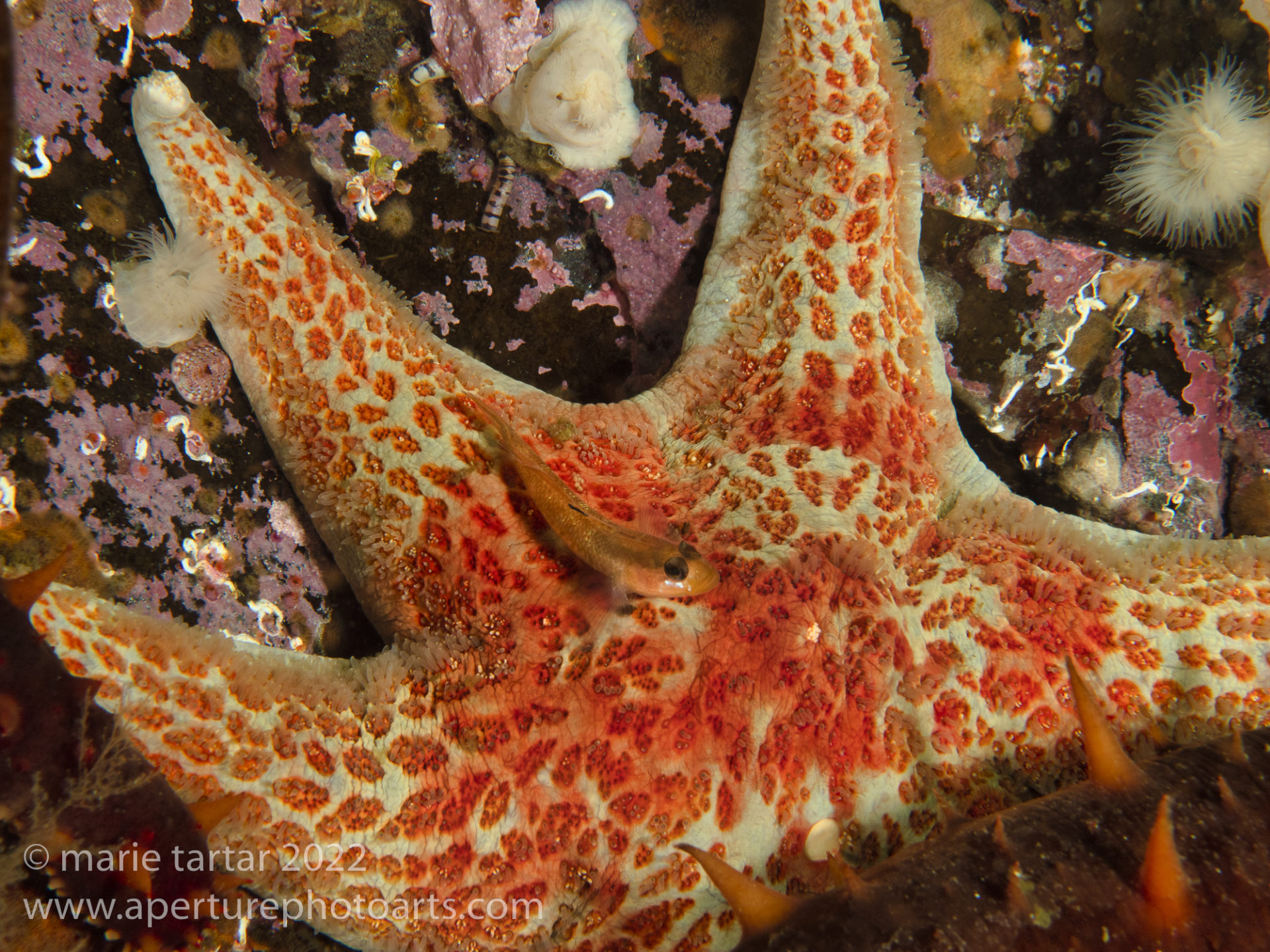


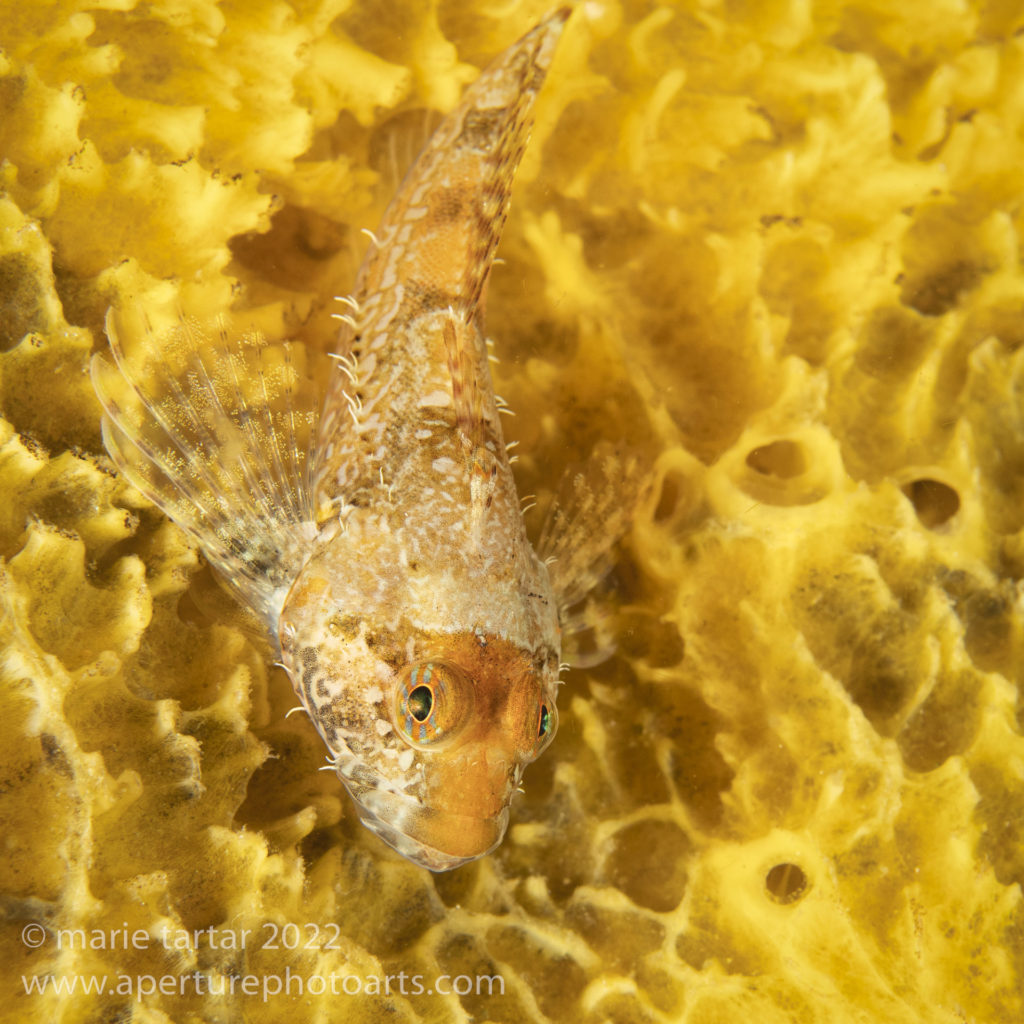


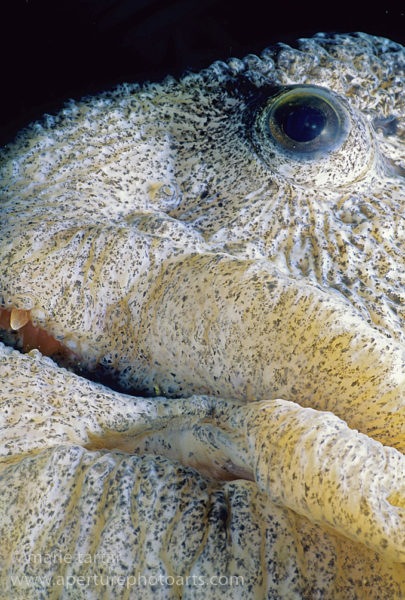
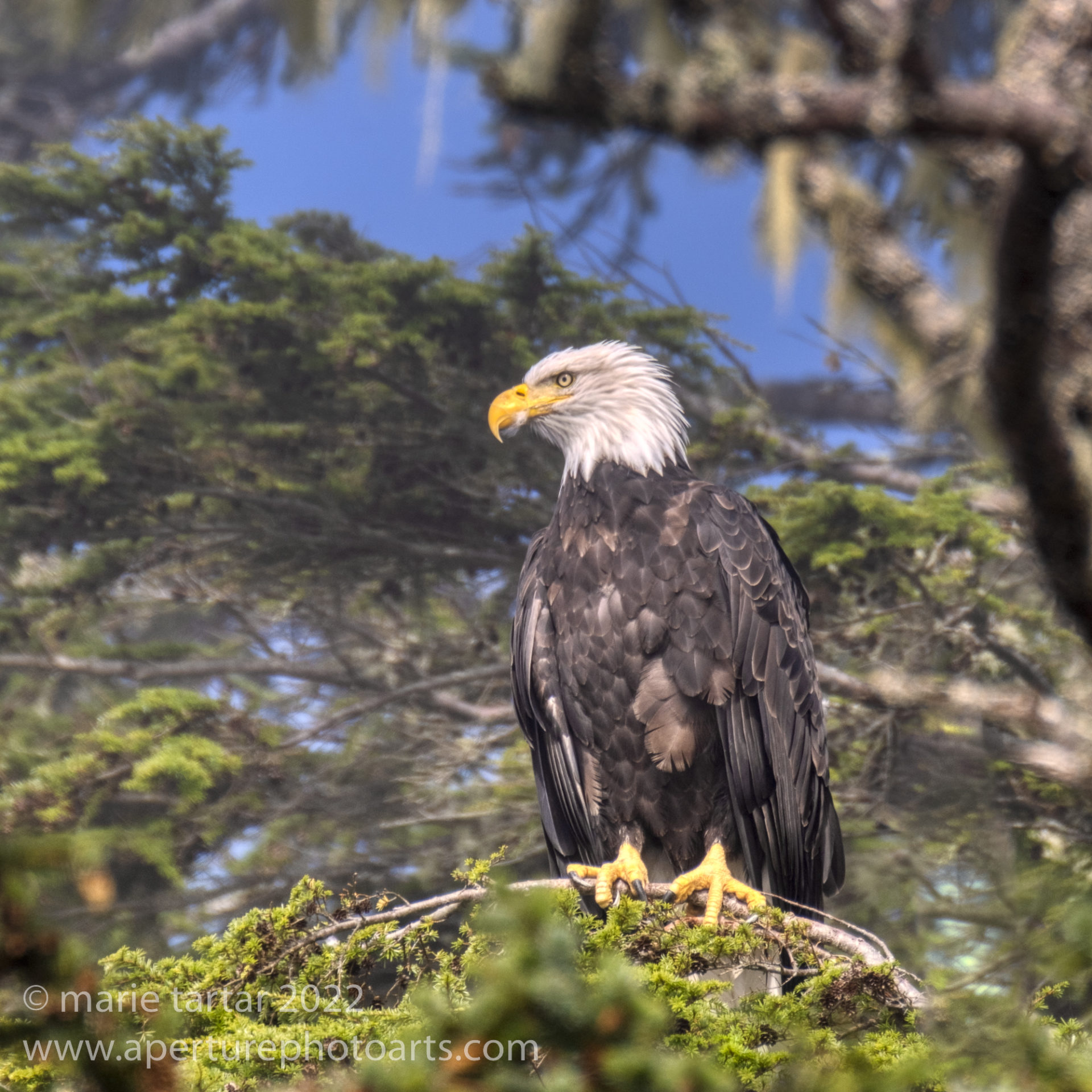
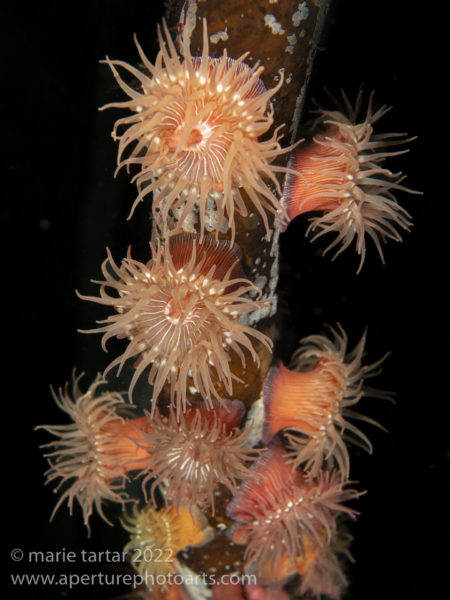

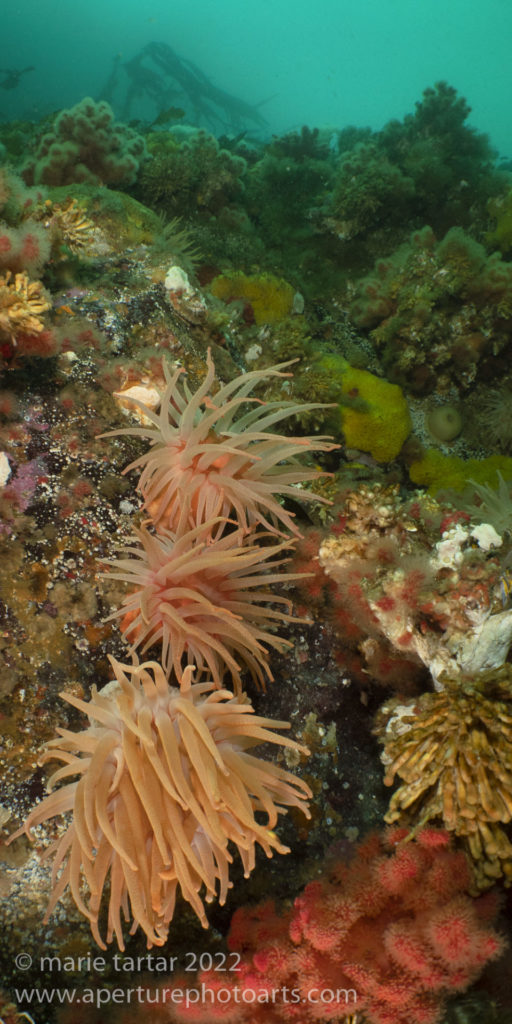
It sounds as if everybody’s equipment was making known its displeasure at having been neglected these past few years. It is so funny that the wolf eels expected you to open sea urchins for you–like dogs expecting humans to do the hard work of treat-seeking!
Animals learn quickly!
-Marie
Wow oh Wow, I feel like I have been suiting up, anxious, excited while diving with you. What an amazing adventure.
Makes you feel alive, for sure! I never truly understood the phrase “ice cream headache” until diving in BC. Or maybe, it’s “I scream!”
-Marie
Such an interesting trip! Second time I tried to die this past year but did partially lose one body part from diving. The knives are sharp and I think would cut stout rope, if the occasion arises again.
Thanks!